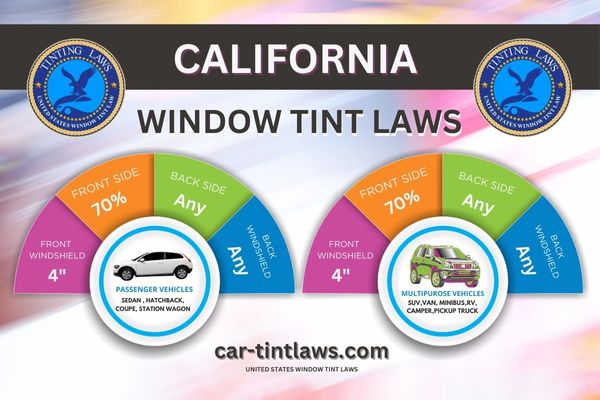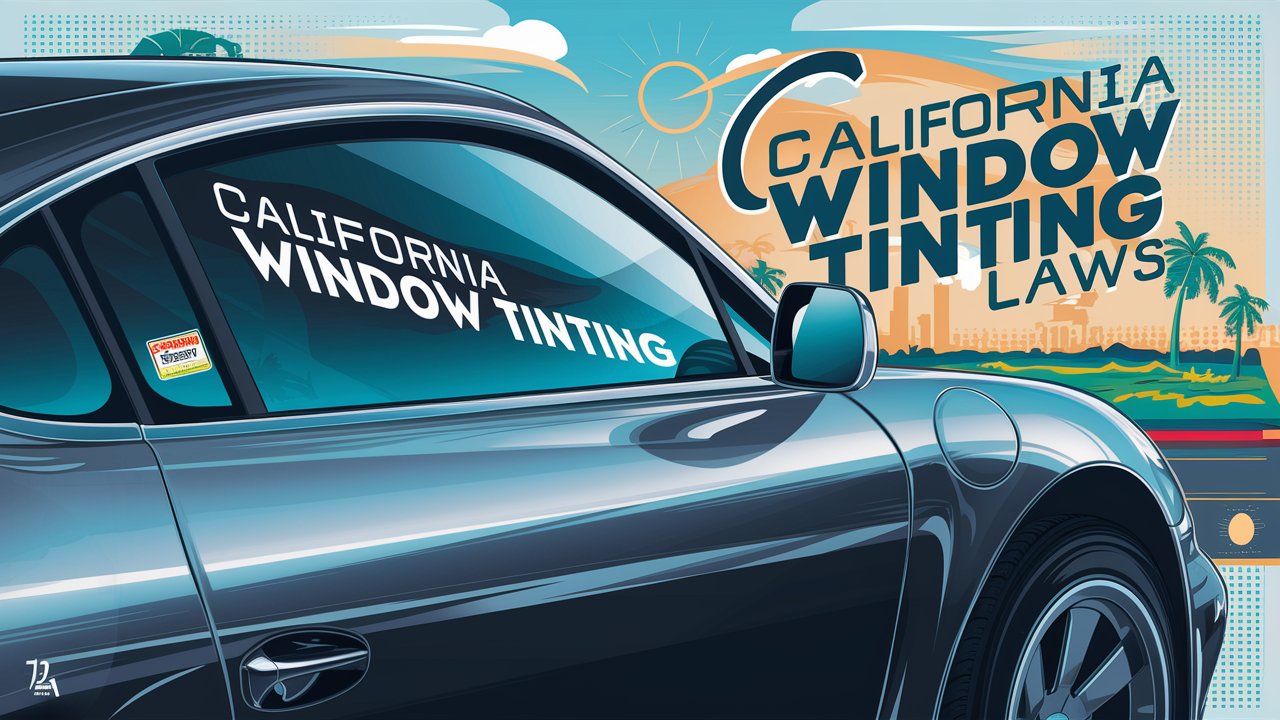When considering window tinting for your vehicle in California, understanding the state’s specific regulations on tint darkness and reflection is vital.
You can’t just choose any tint you like; there are strict rules in place that dictate how dark and reflective your windows can be.
For instance, sedans must allow more than 88% of light into the front side windows, and there are limitations on how much your tint can reflect light.
These laws aren’t just about aesthetics; they are essential for safety and visibility. But what happens if you don’t comply?
Let’s explore the potential consequences and exemptions.
Window Tint Darkness in California
When it comes to tint darkness in California, the regulations vary based on the type of vehicle you drive.
For sedans, the front side windows must allow over 88% of light to pass through if you apply aftermarket tint.
However, for SUVs and vans, any level of darkness is permitted on the back side windows and rear windows.
Tint darkness for sedans:
- Windshield: Non-reflective tint is allowed on the top 4 inches of the windshield.
- Front Side windows: Must allow over 88% light transmission.
- Back Side windows: No specific darkness restrictions.
- Rear Window: No specific darkness restrictions.
Tint darkness for SUV and Vans:
- Front Side windows: The front side windows of SUV and van owners in California must allow over 88% light transmission for safe driving.
- Back Side windows: There are no specific darkness restrictions for the back side windows and rear windows, allowing greater freedom in customization.
- Rear window: There are no specific darkness restrictions for the rear windows, allowing owners to choose any shade they prefer.
Window Tint Reflection in California
When considering window tint reflection in California, you’ll need to understand the regulations for both sedans and SUVs/vans.
Sedans are required to have standard reflection on their front and back side windows, ensuring visibility and safety.
Similarly, SUVs and vans must also maintain standard reflection on these windows to comply with safety standards.
Tint reflection for sedans:
- Front Side windows: Must not be more than 20% reflective.
- Back Side windows: Must not be more than 20% reflective.
Tint reflection for SUV and vans:
- Front Side windows: Must not be more than 20% reflective.
- Back Side windows: Must not be more than 20% reflective.
Other California window tint rules and regulations
- Side Mirrors: No restrictions.
- Restricted Colors: In California, only non-reflective tint is allowed on the front side windows, back side windows, and rear window.
- Certificates: Manufacturers of film need to certify the film they sell in the state. Make sure your tint film is certified.
- Stickers: The sticker/label of compliance to identify legal tinting is required between the film & glass on each tinted window.
- Medical Exceptions: California allows medical exemptions for special tint. For more details about the specific terms of the exemption, consult California state law.
- Penalties: Violating California tint laws can result in fines and a requirement to remove the non-compliant tint.

Medical Exemptions for Window Tint Rules in California
If you have a medical condition that requires shielding from UV rays, California allows window tint exemptions with proper documentation from a licensed medical professional.
According to California window tint laws, these medical exemptions permit the use of window tints with lower visible light transmission (VLT) levels than typically allowed.
This means you can have darker tints on your windows to protect your skin and eyes from harmful UV rays, provided you adhere to specific guidelines.
To qualify, you’ll need to provide detailed documentation from your doctor, outlining the medical necessity for the tint.
The tint itself must be clear, colorless, and transparent, making sure it doesn’t obstruct your view while driving.
Although the law allows for exemptions for lower tint due to medical conditions, you must strictly follow the paperwork requirements and guidelines set by the state.
Importantly, these exemptions do not permit the use of tinting devices at night, even if you have a documented medical condition.
Adherence to these specific guidelines ensures that you can legally benefit from the medical exemption without violating other aspects of California’s window tint laws.
Make sure to file all necessary paperwork to avoid any legal issues.
California Window Tint Ticket Cost
Getting a ticket for violating California’s window tint laws can cost you $25 for a first offense, but repeated violations can lead to much steeper fines and penalties.
The initial fine might seem minor, but don’t let that mislead you. If you’re caught again, the cost skyrockets to a $200 penalty, which is classified as an infraction.
It’s important to make an immediate adjustment to your tint after receiving a ticket to avoid these escalating fines.
Adhering to California’s tint laws isn’t just about the financial hit; it’s about staying within legal boundaries to avoid harsher penalties associated with repeated violations.
The state takes these infractions seriously, and failing to comply can lead to significant cumulative costs.
The combination of fines, penalties, and the need for immediate adjustment can become a substantial burden.
Moreover, repeated violations can place you under closer scrutiny by law enforcement, which might lead to more frequent stops and inspections.
Understanding and complying with California window tint laws is essential.
Ensuring your vehicle’s tint meets the legal standards will save you from the hassle and expense of dealing with fines and penalties.
California DMV Contact Information
To get answers to your questions about window tinting laws, you can contact the California DMV through various methods.
They have office locations throughout the state, provide online contact options, and have phone numbers you can call for assistance.
Whether you need details on tint percentages or want updates on regulations, the DMV is your go-to resource.
DMV Office Locations
Many California DMV offices are conveniently situated throughout the state to assist you with vehicle registration, driver’s licenses, and ID cards.
Whether you’re a new resident or a long-time Californian, finding the nearest office location and its hours of operation is simple.
Just visit the DMV website for detailed information.
California DMV offices are not only crucial for standard services like vehicle registration and obtaining driver’s licenses and ID cards; they also provide valuable information on window tint laws.
If you have specific questions about window tinting requirements, the DMV can offer clarity.
Understanding California’s window tint laws ensures you stay compliant and avoid potential fines.
To make your visit more efficient, it’s advisable to check the hours of operation of your nearest office location before heading out.
This can help you plan your visit better and reduce waiting times.
Additionally, many DMV offices offer online appointment scheduling, which can save you even more time.
Contacting DMV Online
If you need more information or wish to handle DMV-related tasks from the comfort of your home, the California DMV’s online services are your best bet.
These convenient services allow California residents to complete a variety of tasks without needing to visit a DMV office.
You can manage your vehicle registration, driver’s license renewal, and appointment scheduling all through the California DMV’s official website.
The online portal is user-friendly and designed to save you time.
It offers a wide array of forms and manuals that you may need, ensuring you have access to all the necessary documents right at your fingertips.
Additionally, the website’s FAQs section provides answers to common questions, helping you navigate through any uncertainties.
DMV Phone Numbers
Frequently, you may need to contact the California DMV directly for specific inquiries about window tint laws or other regulations.
Reaching out to the DMV can be pivotal for clarifying any uncertainties you might have about California’s tinting laws.
For general inquiries, you can contact the California DMV at 1-800-777-0133.
This number will connect you to a representative who can provide basic information and direct you to the right resources.
If you have specific questions about window tint laws, it’s best to contact the DMV at (916) 657-8035.
This specialized line is equipped to handle detailed questions about tinting regulations, ensuring you receive the most accurate and relevant information.
The DMV website also offers extensive resources on California’s window tint regulations.
By utilizing these resources, you can stay informed and guarantee compliance with the state’s laws.
Whether you’re a vehicle owner or in the auto service industry, staying updated on tinting laws is vital to avoid any legal issues.
Don’t hesitate to contact the DMV if you need further clarification, as staying informed helps maintain both your vehicle’s compliance and your peace of mind.
References
Frequently Asked Questions
What Is the Darkest Legal Tint in California?
You’re wondering about the darkest legal tint in California? For vehicle safety and legal limits, front side windows must have a 70% VLT.
Darker tints offer heat protection, UV protection, and privacy but watch for enforcement issues.
Is a 35% Tint Legal in California?
You’re wondering if a 35% tint is legal in California? It’s not for front windows due to legal limits.
While car modifications like window film can enhance visual appeal, heat reduction, and UV protection, enforcement issues prioritize vehicle safety and privacy concerns.
What Is the Tint Law in California for 2024?
Imagine your car as a knight’s armor; for 2024, front windows need 70% tint for sedans, 88% for SUVs/Vans.
Oversight procedures guarantee safety, while medical and vehicle exemptions exist. Violations face legal penalties.
Why Is Window Tint Illegal in California?
You’re wondering why window tint is illegal in California. It’s not; however, strict regulations exist due to safety concerns, visibility issues, and law enforcement needs.
Tint percentages balance UV protection, glare reduction, heat rejection, and privacy concerns.
Conclusion
Understanding California’s window tinting laws is essential to guarantee your vehicle complies with state regulations.
Remember, sedans and SUVs/vans must maintain more than 88% light transmission on front side windows, and all vehicles must adhere to the 20% reflection limit.
Medical exemptions require proper documentation. Violations can lead to fines and mandatory tint removal.
Stay informed, follow the guidelines, and enjoy safe, legal driving. For more details, contact the California DMV or refer to the official tint law references.
